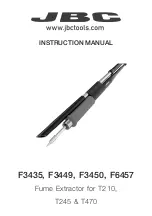
7
WARNING -
If foam or liquid is emitted, switch off
immediately and empty recovery tank. Liquid emitted
could be hazardous as a result of its temperature, or
chemical content.
•
To stop the machine, release solution feed lever (4),
switch off brush motor (C), then vacuum motor (B).
•
Proceed to operate the machine in the normal manner,
releasing cleaning solution as required.
•
For heavy soilage, scrub floor with cleaning solution but
with vacuum motor OFF (B). Scrub floor again picking
up the solution with the vacuum motor on (B).
4.4 Warnings while using the machine
While using the machine, the occurrence of the following
errors is indicated by the illumination of the LEDs (Fig.
10).
•
Vacuum motor overcurrent error LED 1 is flashing and
LED 2 is constantly lit.
•
Brush unit outlet overcurrent error LED 1 is flashing and
LED 3 is constantly lit.
•
Vacuum motor open circuit error LED 1 is flashing and
LED 4 is constantly lit.
•
Brush unit outlet open circuit error LED 1 is flashing and
LED 5 is constantly lit.
NOTE: When any of the above mentioned error signals
are displayed, it is necessary to turn off the machine and
then turn the machine back on again, in order to clear the
error and re-set the machine back to normal functioning.
Fig. 10
4.5 When cleaning is finished
•
When cleaning is finished and before turning off the
machine, stop the dispensing of solution and the rotation
of brushes by releasing levers. Continue with the
vacuum on to remove all of the liquid present on the
floor, and then turn off the vacuum by pressing button 2.
•
Raise the squeegee by pulling the squeegee lifting lever
and releasing it. The lever remains in an upper position
thus maintaining the squeegee blades in the raised
position.
IMPORTANT
– To prevent the deformation of the
squeegee blades always lift up the squeegee at the end
of the cleaning cycle.
•
Remove brush or pad from machine and wash in warm
soapy water.
4.6 Draining and cleaning the recovery tank
At the end of the cleaning cycle or
when the recovery tank is full, it is
necessary to empty the tank by
proceeding as follows:
IMPORTANT
– To dispose of the
recovery water tank, comply with the
standards in force in the country in
which the machine is being used.
•
Position the machine near to a
drain outlet.
•
Disconnect the drain hose from the
support at the rear of the machine.
•
Remove the cap from the hose and
drain all the water contained in the
tank (Fig. 11).
Fig. 11
WARNING
- At the end of the cleaning operations it is
necessary to clean the recovery tank to prevent deposits
or scaling and the proliferation of bacteria, odours or
mould.
•
Remove the cover and clean the inside of the cover and
the vacuum safety float with running water.
•
Leaving the hose lowered and the cap off, add water
though the upper opening, cleaning the inside of the
tank until clean water comes out of the drain hose.
•
Replace all components in reverse order.
4.7 Draining and cleaning the solution tank
WARNING
– At the end of the cleaning operation, it is
necessary to drain and clean the solution tank to prevent
deposits or scaling.
After draining the recovery tank, drain the clean water
tank as follows:
•
Position the machine over a drain outlet.
•
Turn the drain connector outwards (Fig. 12).
Fig. 12
•
Push the hose clip inwards and at the same time remove
the cap and let all the water drain out.
•
Wash the inside of the tank, leaving the drain cap off
and flush water through the solution tank filling opening
•
After cleaning, replace the cap, pushing inwards.
IMPORTANT
– To dispose of unused cleaning solution,
comply with the standards in force in the country in which
the machine is being used.









































